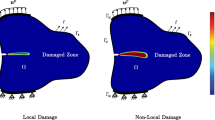Abstract
In this article, an introduction of pseudo-stress for local residual and an algebraic derivation of consistent tangent are presented. The authors define a coupled problem of the equilibrium equation for the overall structure and the constrained equations for stress state at every material point, and the pseudo-stress and the derived consistent tangent can be implemented easily to finite element analysis. In the proposed block Newton method, the internal variables are also updated algebraically without any local iterative calculations. In addition, the authors demonstrate the performance of the proposed approach for both \(J_{2}\) plasticity and \(J_{2}\) plasticity under plane stress state.











Similar content being viewed by others
References
Yamamoto T, Yamada T, Matsui K (2021) Simultaneously iterative procedure based on block newton method for elastoplastic problems. Int J Numer Methods Eng 122(9):2145–2178
Kulkarni DV, Tortorelli DA (2005) A domain decomposition based two-level newton scheme for nonlinear problems. In: Barth TJ, Griebel M, Keyes DE et al (eds) Domain decomposition methods in science and engineering. Springer, Berlin, pp 615–622
Michaleris P, Tortorelli D, Vidal C (1994) Tangent operators and design sensitivity formulations for transient non-linear coupled problems with applications to elastoplasticity. Int J Numer Methods Eng 37(14):2471–2499
Michaleris P, Tortorelli D, Vidal C (1995) Analysis and optimization of weakly coupled thermoelastoplastic systems with applications to weldment design. Int J Numer Methods Eng 38(8):1259–1285
Wisniewski K, Kowalczyk P, Turska E (2003) On the computation of design derivatives for Huber–Mises plasticity with non-linear hardening. Int J Numer Methods Eng 57(2):271–300
Wallin M, Jönsson V, Wingren E (2016) Topology optimization based on finite strain plasticity. Struct Multidiscip Optim 54:783–793
Okada J, Washio T, Hisada T (2010) Study of efficient homogenization algorithms for nonlinear problems: approximation of a homogenized tangent stiffness to reduce computational cost. Comput Mech 46(2):247–258
Lange N, Hütter G, Kiefer B (2021) An efficient monolithic solution scheme for FE2 problems. Comput Methods Appl Mech Eng 382(113):886. https://doi.org/10.1016/j.cma.2021.113886
Fritzen F, Hassani MR (2018) Space-time model order reduction for nonlinear viscoelastic systems subjected to long-term loading. Meccanica 53:1333–1355
Matthies HG, Steindorf J (2003) Partitioned strong coupling algorithms for fluid-structure interaction. Comput Struct 81(8):805–812
Matthies HG, Niekamp R, Steindorf J (2006) Algorithms for strong coupling procedures. Comput Methods Appl Mech Eng 195(17):2028–2049
Ellsiepen P, Hartmann S (2001) Remarks on the interpretation of current non-linear finite element analyses as differential-algebraic equations. Int J Numer Methods Eng 51(6):679–707
Kulkarni DV, Tortorelli DA, Wallin M (2007) A Newton–Schur alternative to the consistent tangent approach in computational plasticity. Comput Methods Appl Mech Eng 196(7):1169–1177
Simo J, Taylor R (1985) Consistent tangent operators for rate-independent elastoplasticity. Comput Methods Appl Mech Eng 48(1):101–118
Hartmann S, Quint KJ, Arnold M (2008) On plastic incompressibility within time-adaptive finite elements combined with projection techniques. Comput Methods Appl Mech Eng 198(2):178–193
Nakshatrala P, Tortorelli D (2015) Topology optimization for effective energy propagation in rate-independent elastoplastic material systems. Comput Methods Appl Mech Eng 295:305–326
Owen D, Hinton E (1980) Finite elements in plasticity: theory and practice. Pineridge Press, Swansea
Hartmann S (2005) A remark on the application of the Newton–Raphson method in non-linear finite element analysis. Comput Mech 36(2):100–116
Rempler HU, Wieners C, Ehlers W (2011) Efficiency comparison of an augmented finite element formulation with standard return mapping algorithms for elastic-inelastic materials. Comput Mech 48(5):551–562
Braudel H, Abouaf M, Chenot J (1986) An implicit and incremental formulation for the solution of elastoplastic problems by the finite element method. Comput Struct 22(5):801–814
Braudel H, Abouaf M, Chenot J (1986) An implicit incrementally objective formulation for the solution of elastoplastic problems at finite strain by the F.E.M. Comput Struct 24(6):825–843
de Souza Neto E, Peric D, Owen D (2008) Computational methods for plasticity: theory and applications. Wiley, New York
Simo J (1998) Numerical analysis and simulation of plasticity. Numerical methods for solids (part 3) numerical methods for fluids (part 1), handbook of numerical analysis, vol 6. Elsevier, B.V., pp 183–499
Simo J, Hughes T (1998) Computational inelasticity. Springer, New York
Voce E (1955) A practical strain hardening function. Metallurgia 51:219–226
Cook RD, Malkus DS, Plesha ME et al (2001) Concepts and applications of finite element analysis, 4th edn. Wiley, New York
Simo J (1988) A framework for finite strain elastoplasticity based on maximum plastic dissipation and the multiplicative decomposition: Part I. Continuum formulation. Comput Methods Appl Mech Eng 66(2):199–219
Simo J (1988) A framework for finite strain elastoplasticity based on maximum plastic dissipation and the multiplicative decomposition. Part II: computational aspects. Comput Methods Appl Mech Eng 68(1):1–31
Acknowledgements
This work was supported by JSPS KAKENHI Grant Numbers JP16H03914, JP20H04198, JP22K14147.
Author information
Authors and Affiliations
Corresponding author
Ethics declarations
Conflict of interest
The authors have no competing interests to declare that are relevant to the content of this article.
Additional information
Publisher's Note
Springer Nature remains neutral with regard to jurisdictional claims in published maps and institutional affiliations.
Rights and permissions
Springer Nature or its licensor (e.g. a society or other partner) holds exclusive rights to this article under a publishing agreement with the author(s) or other rightsholder(s); author self-archiving of the accepted manuscript version of this article is solely governed by the terms of such publishing agreement and applicable law.
About this article
Cite this article
Yamamoto, T., Yamada, T. & Matsui, K. Introduction of pseudo-stress for local residual and algebraic derivation of consistent tangent in elastoplasticity. Comput Mech 71, 1081–1091 (2023). https://doi.org/10.1007/s00466-023-02268-0
Received:
Accepted:
Published:
Issue Date:
DOI: https://doi.org/10.1007/s00466-023-02268-0




